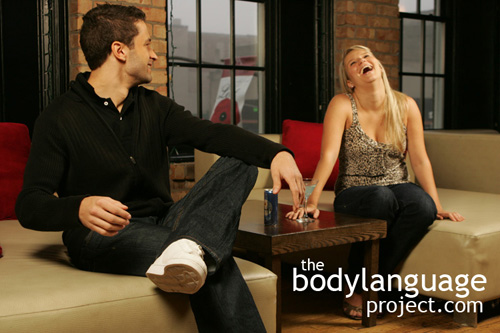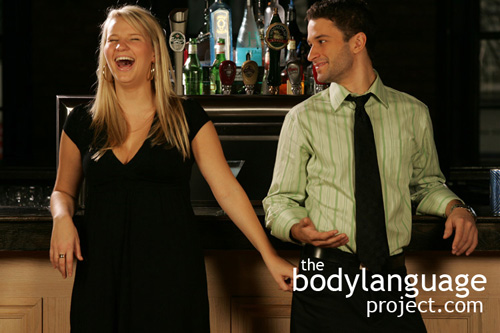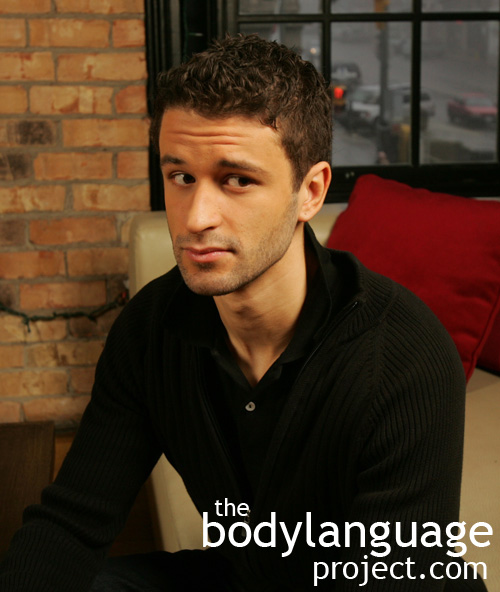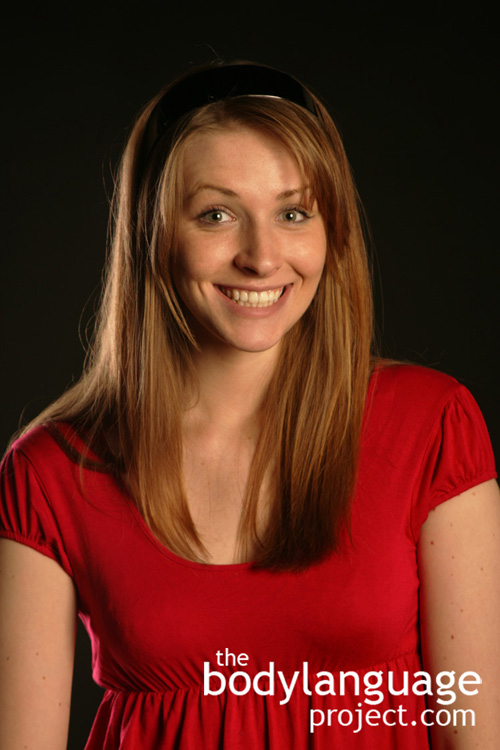Body Language of Shoulder Shrugs or Shoulder Rise
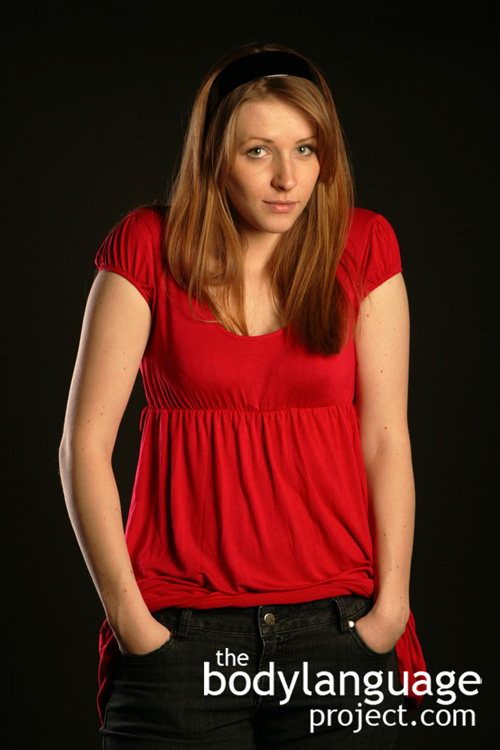 Cue: Shoulder Shrugs or Shoulder Rise.
Cue: Shoulder Shrugs or Shoulder Rise.
Synonym(s): Shrugs, Ducking, Hunched Shoulders, Turtling, Head Ducking.
Description: The shoulder shrug posture happens as the head seems to sink inside the shoulders, however, what is really happening is that the shoulders are slowly being raised so the neck disappears taking the head with it. It is as if the head is being swallowed by the shoulders. Shrugs can appear as micro-movements barely perceivable or as full on shrugs where the shoulders nearly touch the ears.
In One Sentence: Shoulder shrugs indicate lack of knowledge and ultimately submission.
How To Use it: Shrug the shoulders when you don’t know the answer to a problem or you wish to show submission. Shoulder shrugs can be used to show others that you accept defeat when it is coupled with a lowered head. Therefore, you may consider using it when pleading for forgiveness.
In dating, women can use the shoulder shrug to take on a smaller profile in order to create the impression of submissiveness and therefore elicit a protective and caring partner. Children and men can also do the same. When submission occurs, it produces a sympathetic response when it is seen by an empathetic viewer.
Context: General.
Verbal Translation: a) “My shoulders raise for a nano-second showing that I don’t know the answer.” b) “My head pulls down to my shoulders, palms up as a shield, eyebrows raised with my head tilted shows that I’m drawing inward and don’t want to get involved – so leave me out of this.” c) “I’m sorry I don’t know the answer and I’m shrugging to show others that I’m not a threat and wish not to provoke. In other words, I’m sorry I don’t know, but please go easy on me. I’m not a target, I’m submissive.”
Variant: Shrugs contain key elements such as hunched shoulders where the shoulders are raised and lowered, hands twisted into the palms up position (one or both hands), lowered mouth corners (while hands and head remain still), raised eyebrows (which shows astonishment, indifference, and bewilderment). Each variant, independent of one another, can carry the meaning of the shrug.
See Uneven Shoulder Shrugs and Palm Up Displays or The Rogatory Posture.
Cue In Action: a) The teacher called on Dave but he didn’t know the answer because he hadn’t read the report. His shoulders flinched upward, barely raising, as he froze like a deer in the headlights. b) There was a mess in the staff room and the boss had made a point of rounding up the culprits to get the job done. She invited them to step forward, but in unison the staff raised their shoulders as if they were not to blame and didn’t want to help fix the mess. c) After cussing her out without giving her time to explain, he felt it was his duty to offer a box of treats and flowers. He lowered his head, turned his palms up and shrugged his shoulders. He didn’t need to say anything. She understood he felt sorry for what he had done.
Meaning and/or Motivation: A universal expression of doubt and uncertainty. Shoulder shrugs can signify apology, disbelief, ignorance, indifference (lack of interest), helplessness, resignation, discomfort, low self-confidence, insecurity, weakness or powerlessness and shame. Many negative emotions are expressed through shoulder shrugs.
A shrug can also mean that you don’t know the answer, that you don’t want to get involved, or imply submissive apology.
Shoulder shrugs in a business context are usually found when someone is centered out on their poor performance. The origin of the “head turtle” is to protect it from harm. For example, when people hear a very loud bang, they will quickly pull their heads inward and down, and tuck in their chins. However, when it is done out of shame, it happens more slowly and deliberately so as to draw even less attention.
Shrugging is also done when people want to appear less significant so they go overlooked and are ignored rather than called on. In business, the head duck will occur when subordinates meet with superiors as they try to stand out less and look less significant or when employees wish to be overlooked during status reports at a boardroom meeting. It might also happen in class when the professor is calling on students who don’t have the answers, or when athletes have to walk back in shame to their dressing rooms after losing an important match.
The shoulders hunching up with palms up indicate a desire to hold a more narrow and protective posture hence it is submissive like a turtle going up in its shell.
The shoulder shrug can also appear in a dating situation where women appear meek and submissive. Shrugging is a childlike posture and happens when a woman let’s her guard down. It is often subtle and occurs subconsciously as a small raise of the shoulders and sometimes is accompanied by an eyebrow flash. Other times it is more pronounced and the head lowers or bows in unison. In this case, the shrug may be held for some time.
Cue Cluster: Shrugs often appear coupled with cowering, eyebrows lifted, palms up, head lowered, head bowed, eyes cast upward and widened, frowning or downturned smiles.
Body Language Category: Appease, Courtship displays, Closed body language, Defensive, Disengagement body language, Embarrassment (nonverbal), Escape movements, Fearful body language, Intention movements, Nonthreatening body language, Palm power, Protective reflexes, Readiness to submit postures, Submissive body language, Universal gestures.
Resources:
Adams, E.S., Mesterton-Gibbons, M., 1995. The cost of threat displays and the stability of deceptive communication. J. Theor. Biol. 175, 405–421.
Boyson, A. R., Pryor, B., & Butler, J. (1999). Height as power in women. North American Journal of Psychology, 1, 109–114.
Burgoon, J. K., & Hoobler, G. (2002). Nonverbal signals. In M. L. Knapp & J. A. Daly (Eds.), Handbook of interpersonal communication (3rd ed., pp. 240–299). Thousand Oaks, CA: Sage.
Burgoon, J. K., Johnson, M. L., & Koch, P. T. (1998). The nature and measurement of interpersonal dominance. Communication Monographs, 65, 308–335.
Brin, Pablo and Oli Richard. Body Posture Effects On Self-Evaluation: A self-Validation Approach. European Journal of Social Psychology. 2009; 39: 1053–1064.
Bertamini, Marco ; Byrne, Christopher ; Bennett, Kate M. Attractiveness is influenced by the relationship between postures of the viewer and the viewed person. i-Perception. 2013. 4(3): 170-179.
Brannigan, Christopher, and David Humphries (1972). “Human Non-Verbal Behaviour, A Means of Communication.” In N. G. Blurton-Jones, ed., Ethological Studies of Child Behaviour (Cambridge: University Press), pp. 37-64.
Cashdan, Elizabeth. Smiles, Speech, and Body Posture: How Women and Men Display Sociometric Status and Power. Journal of Nonverbal Behavior. 1998. 22(4): 209-228.
Carney, D. R., Hall, J. A., & LeBeau, L. S. (2005). Beliefs about the nonverbal expression of social power. Journal of Nonverbal Behavior, 29, 105–123.
Darwin, Charles (1872). The Expression of the Emotions in Man and Animals, third edition (New York: Oxford University Press, 1998).
Ellis, L. (1994). The high and the mighty among man and beast: How universal is the relationship between height (or body size) and social status? In L. Ellis (Ed.). Social stratification and socioeconomic inequality (Vol. 2, pp. 93–111). Westport, CT: Praeger Publishers.
Grant, Ewan (1969). “Human Facial Expressions.” In Man (Vol. 4), pp. 525-36.
Givens, David B. (1977A). “Shoulder Shrugging: A Densely Communicative Expressive Behavior.” In Semiotica (Vol. 19:1/2), pp. 13-28.
Givens, David B. Reading Palm-up Signs: Neurosemiotic Overview of a Common Hand Gesture.” Accepted for publication (Mar. 4, 2015) in Semiotica.
McGrew, W. C. (1972). “Aspects of Social Development in Nursery School Children with Emphasis on Introduction to the Group.” In N. G. Blurton Jones, ed., Ethological Studies of Child Behaviour (Cambridge: University Press), pp. 129-56.
Hall, Judith ; LeBeau, Lavonia ; Reinoso, Jeannette ; Thayer, Frank. Status, Gender, and Nonverbal Behavior in Candid and Posed Photographs: A Study of Conversations Between University Employees. Sex Roles. 2001 44(11): 677-692.
Kimbrell, G. Relationship of the upright agonistic posture in the foot shock situation to dominance-submission in male C57BL/6 mice. Psychonomic Science. 1969. 16(3): 167-168.
Katza, Carmit; Irit Hershkowitz; Lindsay C. Malloya; Michael E. Lamba; Armita Atabakia and Sabine Spindlera. Non-Verbal Behavior of Children Who Disclose or do not Disclose Child Abuse in Investigative Interviews. Child Abuse & Neglect. 2012. 36: 12-20.
http://bodylanguageproject.com/articles/reading-nonverbal-behaviour-child-abuse-cases-encourage-children-divulge-information-truth-telling/
Marsh, Abigail A; Henry H. Yu; Julia C. Schechter and R. J. R. Blair. Larger than Life: Humans’ Nonverbal Status Cues Alter Perceived Size. PLoS ONE. 2009. 4(5): e5707. doi:10.1371/journal.pone.0005707. http://bodylanguageproject.com/articles/large-life-nonverbal-dominance-affects-perception-size/
Meier, B. P., Hauser, D. J., Robinson, M. D., Friesen, C. K., & Schjeldahl, K. (2007b). What’s ‘up’ with God?: Vertical space as a representation of the divine. Journal of Personality and Social Psychology, 93, 699–710.
Meier, B. P., & Robinson, M. D. (2004). Why the sunny side is up: Associations between affect and vertical position. Psychological Science, 15, 243–247.
Meier, B. P., & Robinson, M. D. (2005). The metaphorical representation of affect. Metaphor and Symbol, 21, 239–257.
Meier, B.P., Robinson, M.D., & Caven, A.J. (in press). Why a big mac is a good mac: Associations between affect and size. Basic and Applied Social Psychology.
Melamed, T. (1992). Personality correlates of physical height. Personality and Individual Differences, 13, 1349–1350.
Mondloch, Catherine J. Sad or Fearful? The Influence of Body Posture on Adults’ and Children’s Perception of Facial Displays of Emotion. Journal of Experimental Child Psychology. 2012. 111(2): 180-196.
Middleton, W. C., &Moffett, D. C. (1940). The relation of height and weight measurements to intelligence and to dominance-submission among a group of college freshmen. Research Quarterly of the American Association for Health, Physical Education, and Recreation, 11, 53–59.
Montepare, J. M. (1995). The impact of variations in height on young children’s impressions of men and women. Journal of Nonverbal Behavior, 19, 31–47.
Matsumura, Shuichi ; Hayden, Thomas J. When should signals of submission be given?–A game theory model. Journal of Theoretical Biology. 2006. 240(3): 425-433.
Navarro, Joe. 2008. What Every BODY is Saying: An Ex-FBI Agent’s Guide to Speed-Reading People. William Morrow Paperbacks.
Prieto, A. G., & Robbins, M. C. (1975). Perceptions of height and self-esteem. Perceptual and Motor Skills, 40, 395–398.
Pease, Barbara and Allan Pease. 2006. The Definitive Book of Body Language Hardcover. Bantam.
Robinson, Michael D. ; Zabelina, Darya L. ; Ode, Scott ; Moeller, Sara K. The vertical nature of dominance-submission: Individual differences in vertical attention. Journal of Research in Personality. 2008. 42(4): 933-948.
Rule, Nicholas, O.; Reginald B. Adams Jr.; Nalini Ambady and Jonathan B. Freeman. Perceptions Of Dominance Following Glimpses Of Faces And Bodies. Perception. 2012; 41: 687-706 doi:10.1068/p7023
http://bodylanguageproject.com/articles/people-can-read-dominance-split-second
Sturman, Edward D. Invluntary Subordination and Its Relation to Personality, Mood,
and Submissive Behavior. Psychological Assessment. 2011. 23(1): 262-276 DOI: 10.1037/a0021499
http://bodylanguageproject.com/articles/nonverbal-submission-men-women-depression-critical-examination-use-disuse-submission/
Schubert, T. W. (2005). Your highness: Vertical positions as perceptual symbols of power. Journal of Personality and Social Psychology, 89, 1–21.
Schwartz, B., Tesser, A., & Powell, E. (1982). Dominance cues in nonverbal behavior. Social Psychology Quarterly, 45, 114–120.
Stepper, S., & Strack, F. (1993). Proprioceptive determinants of emotional and nonemotional feelings. Journal of Personality and Social Psychology, 64, 211–220.
Schenkel, Rudolf. Submission: Its Features and Function in the Wolf and Dog. American Zoologist. 1967. 7(2): 319-329.
Sommer, Robert (1969). Personal Space: The Behavioral Basis of Design (Englewood Cliffs, New Jersey: Prentice-Hall).
Teixeira Fiquer, Juliana; Paulo Sérgio Boggio and Clarice Gorenstein. Talking Bodies: Nonverbal Behavior in the Assessment of Depression Severity. Journal of Affective Disorders. 2013. 150: 1114-1119.
http://bodylanguageproject.com/articles/using-nonverbal-behaviour-to-assess-depression-severity/
Tiedens, Larissa Z ; Fragale, Alison R. Power moves: complementarity in dominant and submissive nonverbal behavior. Journal of personality and social psychology. 2003. 84(3): 558-68.
Tracy, J. L., & Robins, R. W. (2004). Show your pride: Evidence for a discrete emotion expression. Psychological Science, 15, 194–197.
Tracy, J. L., & Matsumoto, D. (2008). The spontaneous expression of pride and shame: Evidence for biologically innate nonverbal displays. Proceedings from the National Academy of Sciences, 105(33), 11655–11660.
Tracy, J. L., & Robins, R. W. (2007). The prototypical pride expression: Development of a nonverbal behavior coding system. Emotion, 7(4), 789–801.
Walsh, Joseph ; Eccleston, Christopher ; Keogh, Edmund. Pain communication through body posture: The development and validation of a stimulus set. Pain. 2014 155(11): 2282-2290.
Welker, Keith M. ; Oberleitner, David E. ; Cain, Samantha ; Carré, Justin M. Upright and left out: Posture moderates the effects of social exclusion on mood and threats to basic needs. European Journal of Social Psychology. 2013 43(5): 355-361

